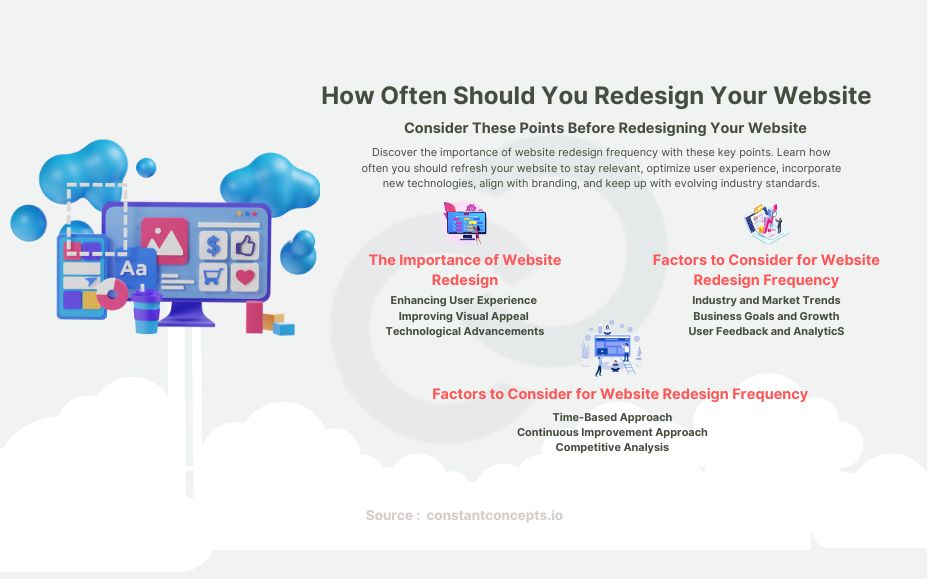The Importance of Website Redesign
Enhancing User Experience and Navigation
Imagine visiting a website that not only has a modern and visually appealing design but also provides a personalized and immersive user experience. As you land on the homepage, you are greeted with a stunning hero image or video instantly captures your attention. The layout is clean and well-structured, making it easy to navigate and find the information you need.
A website redesign can achieve this by implementing a fresh and contemporary visual design that aligns with the latest design trends. Updating the layout and structure makes information more organized and easily accessible, ensuring a seamless user experience.
Let’s say you run an e-commerce store. By redesigning your website, you can revamp the product categories, streamline the checkout process, and implement intuitive search functionality. This way, your customers can easily find what they’re looking for, leading to higher satisfaction and increased conversions.
Improving Visual Appeal and Branding
In the digital realm, aesthetics matter. When visitors land on your website, you have mere seconds to captivate them and leave a lasting impression. A visually appealing website not only catches attention but also conveys your brand identity effectively.
Consider a fashion brand that wants to update its image to reflect the latest trends. Through a redesign, they can incorporate modern color palettes, sleek typography, and eye-catching visuals. By aligning the website’s look and feel with the brand’s evolving style, they create a cohesive experience that resonates with their target audience.
Adapting to Technological Advancements
Remember the days when everyone accessed the internet solely from their desktop computers? Well, times have changed. Today, people browse the web on a wide range of devices, from smartphones to tablets and even smart TVs. Your website must adapt to these technological advancements.
Let’s say you own a restaurant. With a responsive and mobile-friendly redesign, you can ensure that potential customers can easily view your menu, make reservations, and find your location, regardless of the device they’re using. This flexibility not only improves the user experience but also boosts your website’s visibility in search engine results.
Factors to Consider for Website Redesign Frequency
Industry and Market Trends
Industries and markets are like whirlwinds of change. Design aesthetics, functionalities, and user expectations evolve rapidly. If you want to stay ahead of the curve, you may need to redesign your website more frequently, especially if your industry experiences frequent shifts.
Let’s say you’re in the tech industry. Innovation and cutting-edge design are essential to maintaining credibility and attracting tech-savvy customers. By keeping a close eye on industry trends and implementing them in your website redesigns, you demonstrate your commitment to staying current and relevant.
Business Goals and Growth
Your website should be a reflection of your business goals and aspirations. If you’re going through a significant rebranding, expanding your services, or targeting new markets, a redesign becomes necessary to showcase these changes accurately.
For example, imagine you’re a marketing agency that recently added video production to your services. To highlight this expansion, a website redesign can incorporate video showcases, testimonials from satisfied clients, and updated content that emphasizes your new expertise. By aligning your website with your business growth, you attract potential clients who are specifically looking for video production services.
User Feedback and Analytics
Your website’s users hold valuable insights into what works and what doesn’t. Analyzing user feedback, website analytics, and heat maps can reveal pain points and areas that need improvement. If your website receives negative feedback or has a high bounce rate, it’s a clear signal that a redesign might be in order.
Imagine you run an online store. User feedback and analytics show that customers often abandon their shopping carts at the payment stage due to a complicated and confusing checkout process. Through a redesign, you can simplify and streamline the payment process, reducing cart abandonment and increasing conversions.
Determining the Optimal Redesign Frequency
Time-Based Approach
While there’s no one-size-fits-all answer, a general guideline for website redesign frequency is every 2 to 3 years. This timeframe allows for technological advancements, design trends, and user expectations to evolve, ensuring your website remains fresh and up-to-date.
However, keep in mind that this timeframe can vary based on your industry, business goals, and user feedback. The key is to strike a balance between keeping your website current and avoiding unnecessary disruptions for your users.
Continuous Improvement Approach
Alternatively, you can adopt a continuous improvement mindset for your website. Instead of waiting for a complete overhaul every few years, you make regular small updates and tweaks based on user feedback and analytics. This approach allows for incremental changes, ensuring your website is consistently optimized for the best user experience.
For instance, let’s say you manage a news website. With a continuous improvement approach, you can continuously refine the article layout, optimize page load speed, and experiment with different advertising placements. By addressing issues as they arise and implementing iterative improvements, you can deliver a seamless experience to your readers.
Competitive Analysis
In the competitive landscape of the internet, it’s essential to keep an eye on your competitors. Analyzing their websites can provide valuable insights into their strategies and design choices. If your competitors frequently undergo redesigns, it might be an indication that you need to do the same to stay competitive.
Let’s say you’re in the hospitality industry, running a hotel website. By regularly monitoring competitor websites, you can identify emerging trends, benchmark your own design and functionality against theirs, and make informed decisions about when and how to redesign your website to maintain a competitive edge.
Conclusion
In the digital era, a website is a vital tool for businesses. Regularly evaluating and updating its design is crucial to stay relevant, providing a great user experience, and achieve your business goals. Remember to consider the importance of website redesign, industry trends, user feedback, and your own growth plans when determining the optimal frequency for redesigning.
Ready to give your website a fresh new look? Look no further than Constant Concepts Web Design Company in Scottsdale. Our team of experts specializes in professional and innovative web design services tailored to your unique needs. Whether you need a complete overhaul or incremental improvements, we’re here to revamp your online presence, reflect your brand identity, and deliver an exceptional user experience. Contact us today, and let’s bring your website to the next level!








